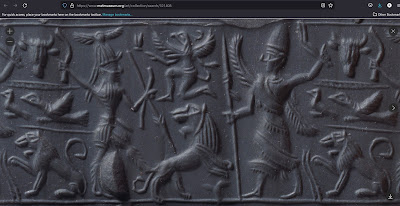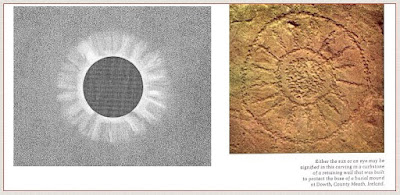A 17th Century BCE Mesopotamian Winged Sun Symbol Crown?
The winged sun symbol VERY closely associated with the crown of the lion slaying deity or ruler depicted in this 17th century BCE Mesopotamian cylinder seal is quite "interesting".
It seems possible, even probable. . . that the tail of the winged sun symbol is either directly connected to, or even incorporated into, the crown of the lion-slaying deity or ruler. . .
Winged sun symbols were inspired by a bird-like pattern that's perceivable in the sun's corona during some total solar eclipses. I searched NASA's 'World Atlas of Solar Eclipse Paths' for total solar eclipses that occurred above Syria and or Cyprus during the 17th century BCE, or just before it, and found that total solar eclipses occurred above Syria in 1704 BCE:
1699 BCE:
And 1650 BCE:
The fact that a total solar eclipse occurred above eastern Turkey, northern Iraq, and Iran on August 29, 1706 BCE, not far north and east of the path of the January 12, 1704 BCE total solar eclipse above Turkey, Syria, Iraq and southern Iran is worthy of note. That is two total solar eclipses above Mesopotamia in less than 18 months.
There is other probable solar eclipse symbolism perceivable in this 17th century BCE cylinder seal, the bird-headed winged anthropomorphic being is readily comparable to similar depictions of the Egyptian "solar falcon god" Horus, the winged human figure with the conical helmet or crown, and the disembodied bull's head which may represent the "solar bull" inspired by the horn-like appearance of the partial phases of solar eclipses.
The winged sun symbol VERY closely associated with the crown of the lion slaying deity or ruler depicted in this 17th century BCE Mesopotamian cylinder seal is quite "interesting".
It seems possible, even probable. . . that the tail of the winged sun symbol is either directly connected to, or even incorporated into, the crown of the lion-slaying deity or ruler. . .
Winged sun symbols were inspired by a bird-like pattern that's perceivable in the sun's corona during some total solar eclipses. I searched NASA's 'World Atlas of Solar Eclipse Paths' for total solar eclipses that occurred above Syria and or Cyprus during the 17th century BCE, or just before it, and found that total solar eclipses occurred above Syria in 1704 BCE:
Winged sun symbols were inspired by a bird-like pattern that's perceivable in the sun's corona during some total solar eclipses. I searched NASA's 'World Atlas of Solar Eclipse Paths' for total solar eclipses that occurred above Syria and or Cyprus during the 17th century BCE, or just before it, and found that total solar eclipses occurred above Syria in 1704 BCE:
1699 BCE:
And 1650 BCE:
The fact that a total solar eclipse occurred above eastern Turkey, northern Iraq, and Iran on August 29, 1706 BCE, not far north and east of the path of the January 12, 1704 BCE total solar eclipse above Turkey, Syria, Iraq and southern Iran is worthy of note. That is two total solar eclipses above Mesopotamia in less than 18 months.
There is other probable solar eclipse symbolism perceivable in this 17th century BCE cylinder seal, the bird-headed winged anthropomorphic being is readily comparable to similar depictions of the Egyptian "solar falcon god" Horus, the winged human figure with the conical helmet or crown, and the disembodied bull's head which may represent the "solar bull" inspired by the horn-like appearance of the partial phases of solar eclipses.
- Get link
- X
- Other Apps
Labels:
bird gods
cylinder seal
Horus
Mesopotamia
mythical birds
solar bull
solar eclipse symbolism
total solar eclipse
winged sun symbols




Comments
Post a Comment